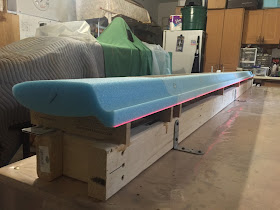Canard extensions (11.0 hrs)
The first order of that day was to extricate the canard from the 2x4s and nails that suspended it in midair. With the part free of the jig, one could finally recognize the shape of the canard.
 |
| "Now, that's starting to look like a real canard!" |
I removed the tape and inspected both sides.
 |
| Top of canard, after some cleanup. |
 |
| Canard bottom looking good. I'll work on this side first. |
After a little cleanup I moved on to the next challenge… building a straight jig on which to mount my canard.
However, measuring over 11' in length (roughly 3.5m), getting this jig straight starts to become difficult, and since the canard can only be as straight as the jig was, it is imperative one spends whatever time necessary on this important item.
Once firmly attached, the extensions would be added, the bottom spar cap built up, and the bottom skin laid.
But let’s not get ahead of ourselves here.
When I purchased the precut foam from Eureka, I also bought all the templates. In this case the nine “K” templates would be called into action.
After checking them to make sure they were all identical, I marked front and back at an arbitrary height of 1.5” (3.8 cm), so that I could use this line to level them on the table. I should mention that being leveled is not a requirement, rather a convenience, and that as long as all the templates are at the same angle, all is well.
 |
| Marking the front of the"K" jigs 1.5" from the bottom |
 |
| I later used a pen to highlight the scribed lines (front and back) |
This is one of those situations where help from technology can really speed things up, especially when working solo. So, after a few futile attempts at juggling multiple variables (9 jigs, 3 dozen shims, a couple of levels, multiple straight edges, a 100 foot roll of string, tape measures, etc.), I decided money might be the perfect "force multiplier" in order to reduce the complex problem into a manageable one.
Enter the Bosch self leveling 360º laser.
 |
| Best $230 I spent in a long time 💸💸💸😀 |
In one word, this thing is awesome! Just turn it on and use it, absolutely no dicking around required!
Luckily for me, I already had a suitable tripod, so me and lady Bosch went straight to work.
 |
| I bought this tripod on Amazon for$20 a while back for shooting videos |
 |
| Using hotel cards as shims |
 |
| Leveling the front of the templates (laser light on black lines) |
 |
| Leveling the back of the templates, then using the glue gun to hold everything together. |
I used a string to mark the forward limit for the templates.
 |
| The string highlights the forward limit of the templates |
 |
| A closer view |
Even though I had everything leveled, I was still surprised and impressed when I sat the canard in the jig upside down, and the back of the canard lined up perfectly with the laser without any "help".
 |
| "I can't argue with that!" |
 |
| This is when one laser sighting is worth 1000 hand measurements |
With the extensions sitting on the jigs beside the canard, it was obvious that the canard was slightly shorter (front to back) than the extensions.
 |
| Extension (made out of 1 piece) bigger than canard (made out of two pieces) |
 |
| Right side has the same issue |
Using gauge blocks and the bottom template “E”, I determined that the canard was shorter by about 0.1” (2.5mm). I am still not sure what that could have caused this, certainly all the weights I had placed on the leading edges during curing didn't help. Perhaps, the canard cores had some slop that was supposed to be taken up by the micro joint. I suppose I might never know, but since the authorized mismatch is 1/8” (3.2mm) I decided to press on and later contour the extensions with the sanding block.
 |
| Bottom template fits the extension perfectly |
 |
| Canard main core checking in 0.1" short |
 |
| Right extension checks good |
 |
| Right canard also 0.1" short |
I then taped the edges of the foam pieces, used wet micro to glue them together, put weights over the assembly, rechecked alignment, and went to bed.
 |
| Taping the left extension before attaching them to the canard |
 |
| Right extension ready to go |
 |
| Right extension attached to the canard |
 |
| Making sure nothing moved |
 |
| Curing overnight |
The next day I removed the tape, and marked both sides of the divide. This foam is so light, correcting the shape mismatch took only a few light strokes of the sanding block. I paid particular attention to the sanding block alignment, and stopped as soon as the black lines on the main side of the canard started to fade.
 |
| Marking the foam to be removed |
 |
| The marks on the main part of the canard (left) are for telling when to stop sanding |
 |
| Foam removed on the extension only. Note the marks are barely touched on the canard. |
 |
| Another view of the sanding |
 |
| Left extension and canard marked before sanding |
 |
| Extension (only) sanded |
 |
| I'll have to sand the top of the extensions (bottom in the photo) once the canard gets out of the jig |
































No comments:
Post a Comment